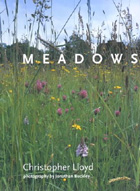Book Review: Meadows
Pam Lewis applauds Christopher Lloyd's latest book about creative gardening with grass: specifically, meadows.


Both title and author of this book, Meadows, are guaranteed magnets for all dedicated meadow enthusiasts such as myself. Readers with a similar love of plants and an eagerness to explore a naturalistic and alternative approach to time-honoured gardening techniques will be inspired and guided by its contents. Turning the pages of this most beautifully illustrated book, even the most conservative fan of the manicured lawn and well-ordered border will surely find encouragement to break new ground and perhaps experiment with an interpretation of a meadow or prairie style of planting in part of their garden.
Mr Lloyd leads the reader into the subject by outlining the geological, climatic and agricultural history of grassland wildflower populations, all of which have contributed to the ephemeral nature of meadows. He refers to the different types of meadow vegetation both in Britain and in other countries, particularly Hungary and North America. We learn that understanding how plants co-exist in permanent meadows, in the communities of cornfields or in prairies will help us to replicate such planting patterns in our gardens. I enjoyed his allusion to the recreational and aesthetic aspects of meadows which are so much part of our deeply entrenched and romantic perception.
He dwells (albeit rather too fleetingly) on the connection between meadows and wildlife, seeming reluctant to fully embrace the conservation issues associated with a garden environment. Although he makes references to several of us who are involved in pioneering work with grassland habitats both in gardens and the wider countryside, I would have expected more emphasis on the importance of the interrelationships between native flora and fauna, crucial as it is.
Whether or not the reader has visited and been overwhelmed by the beauty of the Dixter meadows, here is an insight into the ways that Mr Lloyd, and his mother before him, began the steady process of introducing and testing the viability and longevity of the garden plants and bulbs they planted among the native flowers which existed in a fine grass sward. We are shown how he and Fergus Garret, his head gardener, are continuing to manage, fine-tune and experiment with these same meadows.
With his enchanting photographs, Jonathan Buckley brilliantly and skilfully captures the essence of the subject whether with individual plant portraits to illustrate the author's description or portraying the magic of the full blown meadow community. Mr Lloyd describes the plants family by family, introducing us to perennials, biennuals, annuals, bulbs and grasses that live naturally or can be encouraged to co-habit amenably in this tight-knit community life.
The impact of the Great Dixter meadows has stayed with me since the moment I first saw them many years ago. I believe that Meadows will be a great inspiration and resource for all gardeners, especially those who hanker for the romantic peace of a more naturalistic and wildlife-friendly garden. It should certainly encourage the brave who may even be on the brink of a radical re-think of their whole garden.
Exquisite houses, the beauty of Nature, and how to get the most from your life, straight to your inbox.
Country Life is unlike any other magazine: the only glossy weekly on the newsstand and the only magazine that has been guest-edited by His Majesty The King not once, but twice. It is a celebration of modern rural life and all its diverse joys and pleasures — that was first published in Queen Victoria's Diamond Jubilee year. Our eclectic mixture of witty and informative content — from the most up-to-date property news and commentary and a coveted glimpse inside some of the UK's best houses and gardens, to gardening, the arts and interior design, written by experts in their field — still cannot be found in print or online, anywhere else.
